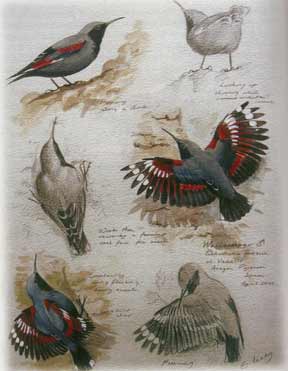The Dutch Birding Association have done it (but then again they always do!) and so have the UK400 club, will others follow suit? Will the Iberian Green Woodpecker, now standing as Picus viridis sharpei soon be universally accepted as different enough to become Picus sharpei, a species in its own right?
Time will tell, but if past experience is anything to go by then the Dutch are usually the first to split, while others reluctantly follow suit some years later! In practical terms this split will mean a lot more birders on the look out for a bird that previously they would have paid scant attention to. I’ve already had an enquiry or two about the distribution of this species in northeast Spain…from Dutch birders, of course.
Posted in General | No Comments »
It’s December. Imagine you’re walking along the base of a steep rock face
somewhere in the Pre-Pyrenees. You detect a movement and look up. There’s a bird, and it’s close enough for you to see its long, slender downcurved bill and its slate-grey and black plumage. A moment later the bird flutters, and on its open, butterfly-like wings you see a dazzling flash of deep crimson.
Rejoice! You are now among the lucky few that have set eyes on one of nature’s jewels: the Wallcreeper. An amazing bird that is at home clinging to vertical rock faces in order to probe into nooks and crannies and pry out spiders and insects with that slender, downcurved bill. Little wonder then that when foreign birders visit this country this is usually the bird they most want to see, or that even the practical-minded Chinese have baptised it with the graceful name of “rock flower”.

In the breeding season the Wallcreeper inhabits sheer cliff faces in the Pyrenees at altitudes of between 2,000 and 3,000m. That means that between May and September the Wallcreeper is rarely an easy bird to see – first of all one has to reach its secluded mountain haunts and then one has to strain the neck muscles, and often the patience too, in order to spot it among towering mountains of naked rock.
That’s one reason though why winter is not all bad: by then Wallcreepers have left their high mountains in Spain to occupy more accessible terrain in the pre-Pyrenees, Montsant, els Ports…even cliffs by the sea at Cap de Creus.
One day last winter I made a personal pilgrimage to the sunny rock faces of Montsec and I received my reward. I took home the Wallcreeper’s colours and a little of its wing-flashing warmth, clutching onto the vision as I descended once more into the blanket of fog enshrouding Lleida and the surrounding plains.
And I hadn’t even strained my neck muscles.
Article published in Catalonia Today December 2007
Read more at http://www.birdinginspain.com
And Steve West’s latest book “Flying over the Pyrenees, standing on the plains”
Posted in Birding and wildlife trips | No Comments »
Christmas is over
The birder’s getting fat,
So don the greasy Barber
And the silly birding hat.
If you haven’t got a Barber
Then any jacket will do
But if you have no birder’s hat
Then Gold help you!
Happy birding for 2008, and may the world be a little better for people and birds by 2009!
Posted in General | No Comments »

